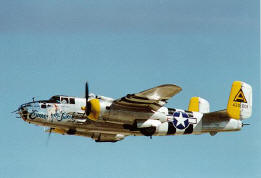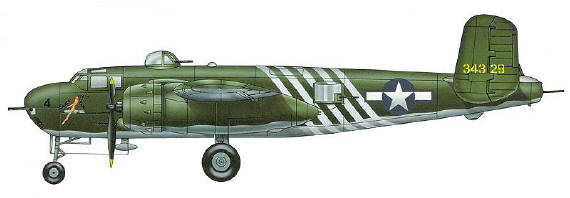

Plane type: Twin-engine Medium Bomber
Manufacturer: North American
Crew: 5 (6 with bombardier: added in B-25J)
Dimensions
Length: 53ft, 5¾ in (16.13 meters)
Height: 16ft 4¾in (4.6 meters)
Wingspan: 67ft 7in (33.5 meters)
Wing Area: 609.8 sq. ft (56.6 sq. m)
Powerplant
-XB-25: 2 x Wright R-2600-9 fourteen-cylinder radial engines @ 1700 h.p. each
-B-25A, B-25B: no change:
-B-25C, B-25D: 2 x Wright R-2600-13 engines @ 1700 h.p. each
-B-25E, B-25F, B-25G, B-25H, B-25J & others: no change
CLICK HERE to read up on the Wright R-2600 engine
Weight
Empty weight: 21100 lbs. (9580 kg)
Weight loaded: 33500 lbs. (15210 kg)
Armament (B-25J)
Total armament: 10 x 50 cal. machine guns, in the following places:
- 2 x 50 cal fixed guns aligned with cockpit, one pair on each side of cockpit
- 2 x 50 cal guns in 1 turret above navigator's compartment
- 2 x 50 cal guns in tail
- 2 x 50 cal guns, 1 in each "side port" on each side of fuselage
- 2 x 50 cal guns in nose, 1 fixed & 1 flexible
Maximum internal bomb load: 3000 lbs
Provision for bomb accommodation on external wing rack: 2400 lbs
Also capable of carrying at 2150 lb. torpedo
Performance
Maximum speed: 303 mph (485 Km/h) @ 13000 ft (3965 m)
Normal range: 1275 miles (2052 km)
Ceiling: 24200 ft (8540 m)
Notes:
An all-around great choice for a medium-bomber, the Allies chose well in this department. Known for its ability to be flown and landed easily, the B-25 Mitchell soon became a favorite among many pilots. Constantly being improved, the later versions were very successful. Versions of the plane were given to the US Navy under the name PBJ and proved to be highly effective in the naval war . One of the Mitchell's finest hours was the Doolittle Raid, in which a group of B-25Bs were led by Jimmy Doolittle, off the carrier Hornet, in a bombing raid on Tokyo. The aircraft became so popular that it was exported to the RAF and USSR, and eventually produced after the war to be used in air forces around the world.
RESOURCES:
Page #1 - Warbird Resource Group
Page #2 - The Flight Line
Page #3 - USAF Museum page
Page #4 - Aircraft of the Second World War
Page #5 - Homepage of WW2 Aircraft
Page #6 - Fighter-Planes.com
Page #7 - Aviation History Online
Page #8 - Cavanaugh Flight Museum

Note: This version has shortened nose length.
![]()
Pictures: